DO-IT News September 2023
Volume 31, Number 2
Meet the 2023 DO-IT Scholars!
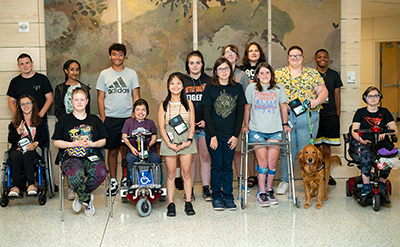
This summer DO-IT hosted its thirty-first annual Summer Study program for DO‑IT Scholars in a brand new format: Hybrid. The first two weeks were hosted online, allowing Scholars to connect across the state while learning about postsecondary education, life on a college campus, challenging academic and career fields, networking, and technology. The last week allowed students to experience these topics in-person with hands-on learning and while getting to apply what they learned online in the classroom and dorms. DO-IT continues to create a safe and inclusive environment for all while allowing Scholars to prepare for college in a variety of methods, all while having fun along the way.
This year's Scholars come from all across Washington State, including Bellevue, Burien, Camas, Cusick, Des Moines, Edmonds, Friday Harbor, Issaquah, Maple Valley, Medical Lake, Redmond, Shoreline, Seattle, Spokane, Tacoma, and Vancouver. They have interests in animals, music, art, reading, history, robotics, choir, movies, gaming, swimming, basketball, traveling, photography, and more.
Scholars expressed interest in a variety of careers, including veterinarian, computer scientist, teacher, doctor, environmental scientist, psychiatrist, lawyer, and actor. The DO-IT Program offers exploration in challenging college programs and offers support for Scholars as they apply and attend school, and eventually apply for exciting and competitive career options.
Primary funding for the Scholars program is provided by Washington State. To learn more, visit the DO-IT Scholars website.
Equal Access: Universal Design of Your NSF INCLUDES Project
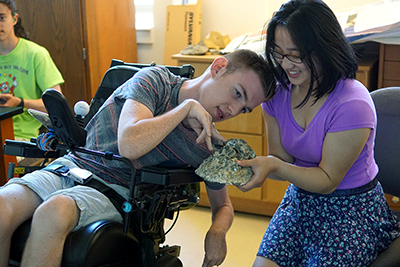
Three NSF Eddie Bernice Johnson INCLUDES projects with ties to DO-IT have worked together to offer a publication called "Equal Access: Universal Design of Your NSF INCLUDES Project." The publication is offered as an accessible PDF and also as an accessible webpage.
The resource was developed through collaboration between the Alliance for Identity Inclusive Computing Education (AiiCE), the Alliance for Students with Disabilities for Inclusion, Networking, and Transition Opportunities in STEM (TAPDINTO-STEM), and a project called AccessINCLUDES. The publication supports the goal of the INCLUDES program, which is to "improve collaborative efforts aimed at enhancing the preparation, increasing the participation, and ensuring the contributions of individuals from groups that have been historically underrepresented and underserved in the STEM enterprise…"
The resource describes ways that projects can plan ahead to embrace the talents of individuals with disabilities by adopting principles of universal design. Universal design involves the design of products and environments to be usable by all people, to the greatest extent possible, without the need for adaptation or accommodations. This means that rather than designing for the average person, your project can design for people with differing native languages, gender identities, racial and ethnic backgrounds, and abilities. The universal design of your NSF INCLUDES project will make its resources, training sessions, meetings, and other offerings welcoming and accessible to a broad audience that include those with disabilities and minimize the need for accommodations for individual participants.
The publication offers suggestions in different areas of project implementation, such as
- Planning, policies, and evaluation;
- information resources and technology;
- project spaces and facilities; and
- staff training.
We hope that other INCLUDES projects use the information from the publication to ensure that their projects and activities are accessible and welcoming to people with disabilities.
Wednesday and Autism Spectrum Disorder
Those who watched the hit Netflix show Wednesday have debated on whether Wednesday Addams is autistic. As a person on the autism spectrum, who watched all episodes of Wednesday as of this writing, I wanted to offer my personal spin on this topic.
A couple traits that are common among individuals on the Autism Spectrum include, among others, diverging from implied social rules during a particular social situation at hand, and remaining fixed over an overall objective.
Both Wednesday and I have diverged out of implied social customs in the situation at hand. For example, the typical response to “How’s it going” is usually “good.” Yet, sometimes I would share more than just “good.” For example, I would say something like, “I’m surviving; got an exam tomorrow.” By saying something besides “good,” I deviated from what may have been the usual response. Here, for Wednesday, she also deviated from the social customs at hand. For example, she sold fudge for her school’s “Outreach Day” in episode 3. When someone sells fudge, they should avoid bad-mouthing the organization that they are with. Yet, Wednesday did the opposite. She referred to the “people of the Amazon” – who supposedly “procured” the chocolate that she was selling – as “oppressed.” She also claimed that the fudge was “authentic,” with air quotes deliberately placed to suggest that the fudge that she was selling was fake, and that sales of that fudge would, according to Wednesday, uphold a “whitewashing of American history” that she felt was “pathetic”. Typically in that situation, the seller should not have said those thoughts out loud to their customers. Instead, Wednesday puts her feelings out there for her customers, agape in bewilderment over what they are hearing.
Another aspect of Wednesday’s traits – resembling an autistic trait – is her inability (at least from the beginning) to make friends immediately. Growing up in elementary school, I did not necessarily have a close friend or two whom I consistently hung out with from time to time. Instead, I was focused, and was probably fixated with, trying to simply do well in school. Here, for Wednesday, she had the opportunity to be close friends immediately with Enid, Wednesday’s bubbly werewolf roommate when Wednesday’s family managed to enroll Wednesday at the Nevermore Academy. Instead of hanging out with Enid as friends, Wednesday remains fixated on getting the sheriff of the town of Jericho to believe her in solving a murder mystery. Even to the point where she asked Enid to come help her, without regard to whether she felt comfortable helping Wednesday, let alone her safety. At the end, Enid became exasperated over Wednesday’s action and told her that Wednesday would “use anyone to get what [she] want, even if it means putting them in danger.”
There are just a couple traits that resemble autism spectrum disorder for Wednesday. Unfortunately, I cannot say definitively that Wednesday really is Autistic. However she holds traits that, at least for me, resonated because of how similar her behavior has been throughout the series. To date, none of the Wednesday cast members nor production crew confirmed whether Wednesday Addams is actually autistic. Whether Wednesday, herself, is actually autistic remains to be seen. At the same time, identifying moments of relatability with the main character are what makes shows, in my view, profoundly impactful.
Three Webinars on Access Issues, Finding Community, and Inclusion
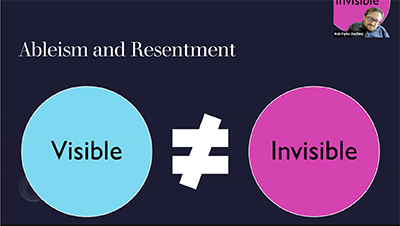
We presented an informative AccessADVANCE Webinar Series during the month of April, featuring panel discussions on three current topics of importance to many of our community members! Recordings of these sessions are available online.
Access Issues for Faculty with Disabilities
Conversations around disability in higher education often focus on access for students with disabilities and overlook the experiences of faculty with disabilities. In this webinar, we heard from faculty with disabilities and disability service providers on topics related to accommodations and universal design, funding for accommodations, and strategies to move beyond mere compliance with related laws.
Our panelists:
- Kimberly Thompson, Senior Director of Disability Services at Seattle University
- Mark Coppin, Director of Disability Services at North Dakota State University
- Jason S. Farr, Assistant Professor of English at Marquette University
- Rob Parke, Associate Professor of Information Technology Practice at the University of Southern California
Finding Community And Connection
Despite an abundance of initiatives focused on equity for faculty with disabilities, very few of these programs center, or even consider, the experiences of faculty with disabilities. In this webinar, we heard from faculty with disabilities about ways to find community and connection with other faculty with disabilities through professional organizations, disability cultural centers, and other strategies.
Our panelists:
- Frances Biderman, Director of the D Center at the University of Washington
- Melissa Vossen Callens, Associate Professor, Department of Communications at North Dakota State University
- Michele Cooke, Professor and Associate Department Head for Professional Development, Department of Earth, Geographic and Climate Sciences at the University of Massachusetts Amherst
- Javin D’Souza, graduate student in the College of Education and Graduate Assistant at the University of Illinois-Chicago Disability Culture Center
Disability Inclusion in the Ongoing Pandemic
The COVID-19 pandemic has had an outsized impact on the disability community. Many people with disabilities are at a high risk for severe COVID and continue to avoid in-person gatherings. Other people have joined the disability community after acquiring long COVID. As organizations and communities return to pre-pandemic norms, what implications does this have for disability inclusion? What can we do to ensure our organizations are welcoming and accessible to people with disabilities?
Our panelists:
- Victoria Chavez, PhD Candidate in Computer Science, Northwestern University
- Emmanuelle Marquis, Professor, Department of Materials Science and Engineering, University of Michigan
- Stephani Page, Director of Strategic Initiatives, Women in Engineering ProActive Network
- Matthew Dowell, Assistant Professor and Director of First Year Writing, Department of English, Towson University
Please share this information with others who may be interested in attending. Sessions will use automatic captions. To request accommodations, please email blaser@uw.edu.
The goal of AccessADVANCE is to increase the participation and advancement of people with disabilities in academic STEM careers through an intersectional approach. AccessADVANCE serves to increase understanding of the issues this group faces and identify promising practices that systematically address issues impacting the career advancement and success of faculty with disabilities. AccessADVANCE is funded by the National Science Foundation (HRD-2017017 and HRD-2017054) to the University of Washington and North Dakota State University. Learn more about AccessADVANCE, join AccessADVANCE Community of Practice, or apply for an AccessADVANCE Minigrant via the AccessADVANCE website.
Learning Local Culture in Australia and New Zealand

My name is Alison Barlow, and I am a student at Green River College (GRC). I found out about the Study Abroad program through Sara Keene, my sociology professor and mentor, who introduced me to Megan, the Study Abroad coordinator. I have a passion for learning and have always loved school; when Megan told me about certain programs, I was immediately hooked.
In August of 2022, I received a letter from Green River College Study Abroad saying my academic records made me a candidate for Studying Abroad. The letter stated that in winter quarter 2023, GRC will be doing a study abroad program in Australia and New Zealand. I applied for the program, which included an interview with the Study Abroad coordinator, and I was accepted.
During fall quarter in addition to taking classes, I began preparing for my study abroad trip. I asked for advice from my cousin who studied abroad in Italy and multiple friends from Green River who are international students. A week into winter quarter, we left for Melbourne, Australia. Dealing with jet lag the first day was a challenge, but the excitement of being in Australia and embarking on this study abroad experience was thrilling.
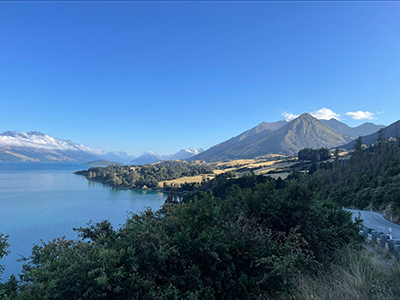
We took a bus to Newman College, a residential college at the University of Melbourne, where we stayed in dorms on campus. We took biology, cultural anthropology, and history of Australia and New Zealand. While we spent some time in a classroom, more than half of our time was spent on field trips and outside; it was very hands-on learning. We had experiences and interactions that cannot be replaced by reading about it in textbooks nor watching videos about it. That is what made the study abroad experience so wonderful.
Our first field trip was to the Melbourne Museum, and we saw the Aboriginal exhibit. I greatly enjoyed this, as I love museums and it was eye opening to see firsthand some aspects of Indigenous Australian culture—a culture that is often overlooked.
We watched several Australian films, including Rabbit Proof Fence, a well-known movie about three half Aboriginal, half European girls who were forcibly taken to Moore River Native Settlement, one of many residential schools designed to assimilate Indigenous Australians and erase their culture. The film documents these girls escape from the residential school. Rabbit Proof Fence is based on a true story.
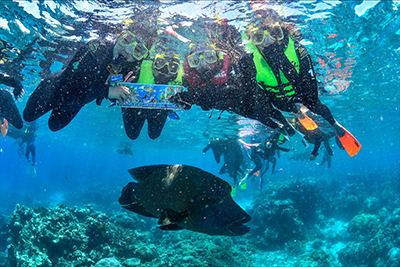
We also went to Healesville Sanctuary, a zoo in Australia. There we saw koalas, kangaroos, and a number of other indigenous animals. One of our tour guides was an Aboriginal woman named Lisa Hodgson, a relative of Molly Craig, Daisy, and Gracie, the girls in Rabbit Proof Fence. I asked her for her perspective on the film, and she informed me it did not accurately represent her relatives’ story, nor did it accurately represent her culture, romanticizing it. While she is glad the film exists, the film also infuriates her. Interacting with her and meeting her was a powerful experience for me. She taught me some words in her language, for example “Nukkin ya borda,”which translates to “see you next time friend,” in the Noongar language.
Australia has a similar history to the USA because it was colonized by the British, it excluded non-Europeans from immigrating to their country, and it has diverse peoples. For instance, we visited one of Melbourne’s Chinatowns. We travelled to Bendigo Golden Dragon Museum and learned a great deal about Chinese immigration to Australia, the role the Chinese played in the development of this country, and the ways in which they keep their culture alive.
January 26 was Australia Day, a holiday that celebrates the arrival of Europeans in Australia. Aboriginals do not celebrate the holiday and they call it Invasion Day. Several of us went to a protest in Melbourne. It was a long march; there were traditional Aboriginal dances, Aboriginal singing, and many signs and posters. The chant was “Always Was, Always Will, Be Aboriginal Land.” I never felt safer at a protest before. I loved going to that protest because it taught me the importance of standing for decolonization and it inspired me to educate myself in the forgotten history of the land that became the United States.
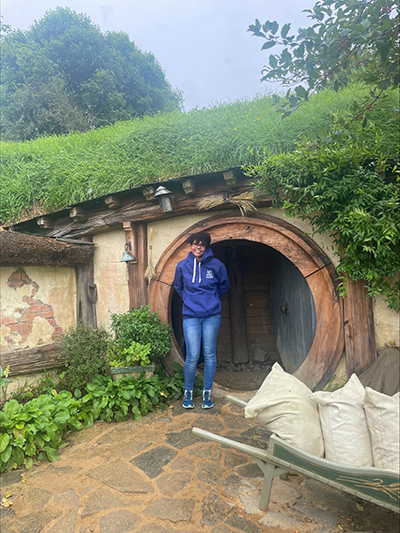
During our break, several of us went snorkeling near the Great Barrier Reef, which was amazing. One cannot comprehend the beauty of reefs unless one snorkels or scuba dives.
After that, we flew to Auckland, New Zealand. The main thing I noticed about Aotearoa (the native Māori name for New Zealand) is how prominent Indigenous peoples and culture are across the country. Māori is an official language in New Zealand. We got to visit the Te Matatini festival, also called Kapa Haka, which is an event held every two years, though this was the first time it was done in Auckland. It was a beautiful event and many of the Māori people performed traditional dances and songs.
On another day, eight of us took a weekend trip to Hobbiton, where The Lord of the Rings (LOTR) movies were filmed. We got to see behind the scenes pictures and videos for LOTR and the Hobbit. And on our last in person class day, we gave biology presentations, and took part in a farewell at the Marae. We then flew back to the United States.
My study abroad experience made me a better, humbler person. It broadened my global perspective on the world and helped me realize there is a bigger world outside the US. It helped me feel more self-confident as a person as well.
Explore Stories Shared by Neurodiverse Students
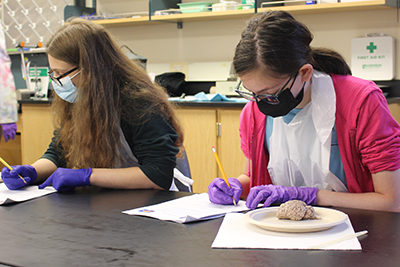
DO-IT’s Neuroscience for Neurodiverse Learners project has published nine new stories from students who identify as neurodiverse and are pursuing science, technology, engineering, and math (STEM) education and careers. For example,
- Alexis, who is pursuing animation at a technical institute, shares her thoughts on the intersection of art and STEM.
- Amanda talks about computer science and the experience of blindness in addition to her identity as a neurodiverse learner.
- Anjelika was the first person in her family to go to college in the United States. She believes diversity among information technology professionals leads to better products for everyone.
- Benjamin shares thoughts on navigating standardized testing, asking for what is needed, and how big wins in research can make the setbacks worthwhile.
As shared by one student, “The thing I appreciate most about my own thinking is the creativity involved. There’s this web of connection in my brain, and I believe that leads to novel ways of putting things together.” We hope you enjoy learning about these students and their experiences, and in the process learn more about promoting the full inclusion of individuals with disabilities in STEM careers.
We're Not in Kansas Anymore!

As the iconic line in the film “Wizard of Oz” goes, “Toto, I’ve a feeling we’re not in Kansas anymore!” But while members of DO-IT’s West Coast team of the NSF Eddie Bernice Johnson INCLUDES Initiative: The Alliance for Students with Disabilities for Inclusion, Networking, and Transition Opportunities in STEM (TAPDINTO-STEM) project didn’t make it to Kansas, they did visit Kansas City, MO, for a convening of the TAPDINTO-STEM Alliance.
Over 85 people attended the convening, held at the University of Missouri-Kansas City campus, March 29-31. About 30 attendees were students with disabilities, all of whom are pursuing science, technology, engineering, and math (STEM) at postsecondary institutions across the country. The remainder of attendees were project staff, project partners, mentors, and postsecondary faculty/staff.
Scott Bellman, DO-IT Center manager and TAPDINTO-STEM West Coast Hub leader, attended the event along with 6 other members from the west coast team and 5 students from West Coast Hub campuses. Scott facilitated two sessions with students called “Accessibility Reviews of STEM Learning Environments,” where students learned how to evaluate STEM learning environments for accessibility and share feedback with the person responsible for the environment. Scott also facilitated an “end-of-day reflection” where attendees were encouraged to think critically about what they had learned during the day and share their thoughts with the group.
There were over twenty sessions offered to attendees. Examples included Accessibility Reviews of STEM Learning Environments, Neurodiverse Edusystems: Proactively Accommodating Variability to Advance Campus Climate, Understanding Student-Professor (mis)Communication, The Team Approach: How Collaborating with your Campus Disability Office can Maximize Student Learning, and an Industry Round Table.
Now that the team is back on our respective campuses, our focus will shift to several upcoming TAPDINTO-STEM events, including an April discussion session with students focused on ethics related to emerging technologies. To learn more about the TAPDINTO-STEM alliance, visit the alliance website at tapdintostem.org or visit the DO-IT led West Coast Hub site.
DO-IT at UW D Center's Open House Event
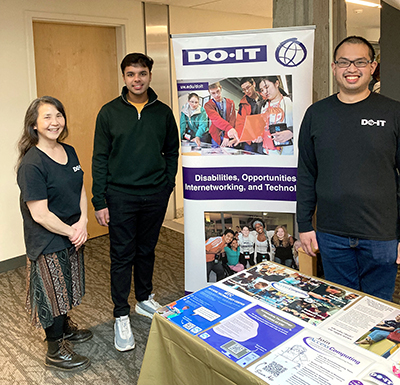
During Winter quarter, the University of Washington D Center, which is the UW's Disability and d/Deaf Cultural Center located inside the HUB, invited DO-IT to attend the D Center's Open House event. The D Center recently underwent renovations, and DO-IT was one of several organizations and affinity groups that participated in the D Center's reopening festivities. These organizations were also in attendance:
- UW ASL Program,
- UW ASL Club,
- Student Legal Services,
- Disability Resources for Students,
- Q Center,
- Huskies for Neurodiversity, and
- ASUW Students with Disabilities Commission.
During the D Center open house event, we spoke to the UW community about DO-IT's programs, including AccessComputing and the Opportunities! Newsletters. We also shared information about the Access Technology Center (ATC), located in Mary Gates Hall. The ATC is a computer lab that provides disabled users in the UW community, such as students, faculty, and staff, with access to UW's computing resources through adaptive hardware and software. The ATC also offers digital accessibility consultation and braille services.
DO-IT is grateful for the opportunity to have been invited to this event and to engage with UW students and staff. We appreciated the chance to share our work and to learn about other affinity groups at UW that support people with disabilities.
Do You Have a Disability Gain?

I recently read an article, The Silver Linings of Parkinson’s Disease, published a year ago in the journal Nature, talking about a survey of people who have Parkinson’s Disease (PD), a neuro degenerative brain condition that affects the nervous system and gradually leads to uncontrolled movements, like shaking and difficulty with balance and coordination. The reason it caught my eye was that the authors conducted a survey on social media, asking people with PD if there was an “upside” or, in the words of one respondent, a “silver lining” to having PD. Keeping in mind that it was a social media survey—which the authors noted was “exploratory” only and not a research project with rigorous methodology—the response was still a bit surprising. Out of 150 respondents, 14% said their life was worse after diagnosis, and 4% provided neutral responses – neither better nor worse. But 82% of respondents identified at least one, and often multiple, “positive outcomes,” “silver linings,” or “disability gains” regarding their diagnosis.
This prompted me to start thinking about how we, as people with disabilities, view ourselves and the particular barriers we encounter in relation to our disabilities. We know the challenges we experience in school, at work, and in everyday life. But what about the silver linings? Are there any? I know a few people with ADHD who have said that the ability to hyperfocus can be an advantage at times—they’re able to concentrate so intensely that can accomplish a lot, or that they can achieve breakthroughs in thinking.
This isn’t a completely new concept; some people with disabilities have been expressing it over the last few years, although perhaps phrasing it a bit differently. In her essay Armchairs and Stares: On the Privation of Deafness (In Bauman and Murray’s, Deaf Gain: Raising the Stakes for Human Diversity), the philosopher Teresa Blankemeyer Burke discusses “Deaf Gain” from which “Disability Gain” is derived. While Blankemeyer Burke goes into a much deeper philosophical examination, she notes a couple of “gains.” For one, Deaf people don’t experience hearing distractions and usually can more deeply concentrate. Because sign languages are visual, with more attention, eye contact, and body language required, there is a “communication intimacy” that is not achieved by hearing individuals—who are more likely to be dividing their attention between the person they’re talking to and their phone, the TV, or their surroundings.
More recently, some people with disabilities have been thinking about their disability as a superpower. For example, in 2019, the children’s book Maybe Autism Is My Superpower was published, recounting a conversation between 13-year old Ben Blanchet and his mother, where Ben described the “unique ways he hears, sees, and thinks about the world around him.” But it’s not only kids who are realizing that their particular disability can be empowering. Thirty-two year old Andrea Dobynes Wagner was interviewed for Elle magazine a couple of years ago in “My Disability Is My Superpower. If Only Employers Could See It That Way.”Andrea is black, female, and legally blind. As a child, she was told that her future was to live with her parents and that she’d never live a “normal” life. But today she has multiple advanced degrees and says “For most of my life, I’ve viewed by disability as a superpower – it’s made me adaptive, innovative and empathetic.”
So, what about you? Do you have a disability gain? What about your disability makes it your superpower?
New Webinar Recordings Available
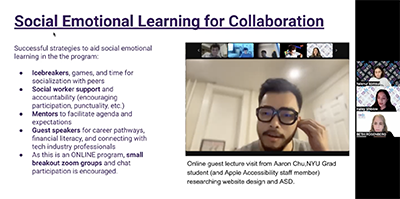
Recordings are now available for two recent webinars hosted by DO-IT Projects AccessComputing and AccessCSforAll.
Considerations for Technology Design for People with Chronic Illnesses
Presenters: Emma McDonnell, Kelly Mack, Sarah Coppola (UW); Litany Lineberry (Mississippi State)
Supported by AccessComputing
In this session, University of Washington PhD students Emma McDonnell (HCDE) and Kelly Mack (CSE) present their work around how technology design can better consider people with chronic illnesses. Following the presentation, there will be a panel where other community members will share their thoughts on the topic.
Turning Neurodiverse Learners Into Leaders
Presenters: Beth Rosenberg, Halenue Komsul, Haley Shibble (Tech Kids Unlimited)
Supported by AccessCSforAll
Tech Kids Unlimited (TKU) works with neurodiverse students to teach them computer science principles, technology and social emotional skills. Learn how neurodiverse teens can become advocates for their own learning through TKU's Digital Agency enterprise—where students work on real digital products for clients and get paid.
Celebrating the Life and Legacy of Judy Heumann
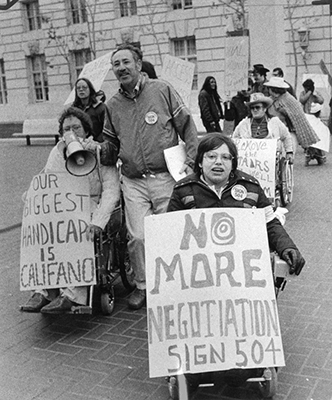
Judith “Judy” Heumann (1947-2023)
Disability rights activist Judy Heumann passed away on March 4, 2023, leaving many of us to reflect on her impact over the years for the rights of people with disabilities. Judy was raised in Brooklyn, New York and contracted polio at age two. At a young age, Judy experienced the many barriers experienced by people with disabilities, including institutionalization and being denied a basic education. These experiences only made her more determined to change society to include all people with the same opportunities, regardless of ability.
Her early activism, recently documented in the film Crip Camp, her talent for turning ideas into actions became evident. Unsurprisingly, she helped organize the historic 26-day Section 504 Sit-In, and uplifted the disabled community's voice in pressing legislators to pass the Americans with Disabilities Act in 1990 into law.
This was an incredible milestone for the disability rights movement, but she wasn’t done fighting. Some of her many influential roles, as noted in judithheumann.com, Judy served as the Assistant Secretary of the Office of Special Education and Rehabilitation Services in the Clinton Administration, served as the first Advisor on Disability and Development at the World Bank, worked as the first Special Advisor for International Disability Rights at the U.S. State Department during the Obama Administration, and was appointed as Washington, D.C.’s first Director for the Department on Disability Services.
To learn more about Judy, she co-authored her memoir, Being Heumann, and its Young Adult version, Rolling Warrior. While a Senior Fellow at the Ford Foundation, she produced the white paper Road Map for Inclusion. You can hear from Judy herself by listening to her podcast, The Heumann Perspective, featuring conversations with disabled changemakers and their allies. Finally, you can watch the powerful documentary, Crip Camp, which highlights the early stages of the disability rights movement from the eyes of the disabled activists, including Judy.
Thank you, Judy, for all you have done. You set the foundation for future disability activists to continue your vision. Look at where we are now. This is your legacy.
Study Skills and Note-taking
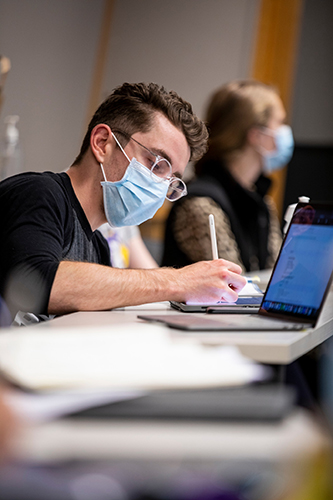
A webinar with Denise Allan, Simplify Experts, with notes compiled by Piper Hawley and Andrea Mano, DO-IT Staff
Denise Allan, Certified Professional Organizer and Founder of Simplify Experts, presented a one-hour webinar to participants in the DO-IT Scholars and Neuroscience for Neurodiverse Learners (NNL) programs. Denise specializes in clients that have attention deficit hyperactivity disorder (ADHD). As Denise shared with us, her kindergarten report card says, “Denise needs to stop organizing the other student's art areas and do her own work.”
After the webinar, an email was sent from Andrea, who is our assistive technologist, to participants, giving them the opportunity to explore assistive technology for note-taking.
DO-IT Scholars and NNL participants have heard some of these tips during workshops led by DO-IT staff during summer study. It was great to hear these tips again, to help cement them into my memory and it was nice to hear new tips from Denise. The following information is a summary of Denise’s tips, alongside recommendations from Andrea that were discussed during the webinar.
Denise’s tips for successful studying and note-taking:
- Attending class
- Be prepared for the day.
- The night before, pack your backpack with all necessary materials, including snacks or assignments.
- Understand your personal time awareness.
- Do you usually run on time or late? If you usually run late, plan to start earlier or pack the night before.
- Do you struggle to wake up with one alarm? Try setting multiple alarms or putting them across the room.
- Plan for travel to and from class, including if traffic is bad at that time of day.
- Give yourself buffer room. You never know when your bus might be delayed! Give yourself freedom for some more challenging transitions if you need it. ,
- How do you want to schedule your classes?
- Do you like to have your classes back-to-back or with more time in between to go back to your dorm and rest?
- If you do have more time in between classes, will you have difficulty attending all of them?
- Taking your hardest classes when you are most energetic is good.
- Where do you want to sit in your class?
- Studies show that students who sit close to the front do better.
- If you sit in the same place, you might get to know the people around you, so you can form a study group or be held accountable to attend class.
- Be prepared for the day.
- Scheduling Study time
- In college you have more free time, but you are the one to drive the decisions about your schedule.
- Live a structured schedule now to create huge life skills for the future.
- To be prepared for an exam, you need to exercise your “brain muscle” alongside assigned homework. Throughout the semester or quarter, review notes and study previous concepts to keep them fresh for when you’ll be tested on them.
- Use your planner/calendar to keep track of your exams and work.
- Block the time in your calendar for studying for an exam.
- Figure out times when you can review your notes and go to Office Hours if you need help before the exam.
- Plan free time so you can relax.
- The Pomodoro Technique is one way to manage your time when studying or doing other similar tasks. Set a timer (25 minutes) for focusing and working, and when the timer beeps, allow yourself a 3 to 5-minute break.
- Your study area
- Do you like to study in a group area or in an area where you aren’t distracted by others walking by?
- If you study in your dorm room, working on your bed is not good. Rest spaces and work spaces are ideally separate.
- It is not good for your posture.
- While alert and working in bed, rather than sleeping, you end up creating confusing signals that make it more difficult to work, and more difficult to sleep at night.
- You might choose to have white noise in the background to help you focus or you may find that it is too distracting when you are studying.
- A sleep hygiene tip for good sleep is to set technology aside 30 minutes to 2 hours before bed.
- Note-taking
- When you are note-taking, you are actively choosing what you want to keep a record of from the lecture.
- One method is to keep an outline format for notes, capturing what you feel is important (key terms and phrases).
- You can underline information that you don’t understand so you can go into Office Hours to ask questions or email for help later.
- note-taking helps you to study for exams.
- Organized notes help them stay useful to future you! s Writing the date for each lecture on a note, and keeping all notes for one subject in a notebook are two important organizational techniques
- Handwriting notes is a kinesthetic process and some people can process information better when handwriting notes because of this. Others find that typing/keying in the notes is better.
- Doodling in the margins of notes can help keep your mind engaged but don’t let doodling take over.
- Immediately after class, before you leave the classroom, review your notes, and indicate any connections you have made. If you can’t review them right away, go back over them when you get home or that evening.
Additional tips from Denise
- Be more proactive than reactive.
- One hour of planning creates three hours of free time each week. By planning for the upcoming week on Sunday, you’ll be able to see when you are really busy or when you have time to catch up on things.
- Get enough sleep.
- Get moving! Exercising and building movement into your day help you to stay healthy—and focused.
- Have a high-protein diet and don’t rely on energy drinks.
- 80% full - you want your schedule only 80% full, so you have free time to relax.
Technology and Note-taking Skills - information from Andrea
- A system for recording lectures and note-taking is vital.
- Being efficient in note-taking requires having a system. For example, if you use assistive technology to record the audio from an entire lecture, when you want to listen to specific parts, you will have to listen to the entire lecture again, unless you have the ability to note important parts.
- There are lots of note-taking systems, but here are a few common ones:
- Per Denise, one method is to take notes in an outline formunderlining things you don’t understand and highlighting things that you want to study more.
- Cornell notes are another style of note-taking where you place information in one of three places on a prepared sheet of paper. The three areas are: Notes (important details, key concepts), Cues (questions and comments) and Summary (an overview of the topic in question).
- Glean, the makers of a software that records and transcribes audio have a note-taking method called CORI. CORI stands for: Capture, Organize, Refine, Integrate.
- The Stoplight method is a way to annotate notes, as you are taking them:
- Highlight things in Red if “you are lost” and you need to ask for help from a teacher.
- Highlight notes in Yellow if “you almost got it”, but you need to review it a few more times to have it integrated into your knowledge.
- Highlight notes in Green if “you’re a pro” and you are confident on this topic.
- Mind-mapping is where you write a main topic in the middle of your page in a circle, and then branch off with subtopics.
- Here are some technologies that can help record lectures or help with note-taking.
- Glean software - records audio and allows you to annotate and add notes that sync with the audio.
- Smartpens such as the NeoSmartPen or the LiveScribe (Echo, Symphony, Echo2) Smart pens or Moleskine (Ellipse) smart pen - records audio and allows you to annotate or add notes that sync with the audio.
- Microsoft Word 365 - allows you to record audio or upload audio into Word, and then can transcribe it into text which you can highlight or edit.
- E-ink writing notebooks such as RocketBooks and Remarkable that enable you to take hand-written notes and save them onto your computer.
- Otter AI or Otter Voice - Some Schools use Otter AI to record and transcribe lectures.
- Inspiration or Mindomo mind-mapping software
- Note-taking services
- Note-taking expresshttps://notetakingexpress.com/ Notetaker Express is a note-taking/transcription service that a Scholar has mentioned is available to him through his school. The service records the lecture, and then transcribes the lecture for the Scholar. It takes a few days as Notetaker Express staff have to transcribe/check the transcription. I haven’t used this system.
- TextCompacter - summarizes the text.
- Chrome extensions such as “Live Transcribe” on an android phone or a Chromebook, to record a lecture and have it transcribed into electronic text.
- Orcam
- Other resources for notetaking can be found from Jetpens at https://www.youtube.com/watch?v=ihj8Ue_SR0Q.
2022 Scholars Share Their Experiences
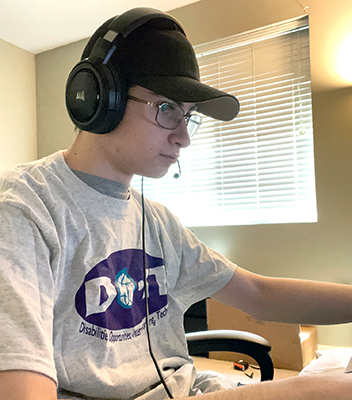
Web Design Experience
By Cameron, 2022 Scholar
During 2022 DO-IT Summer Study I enjoyed the Web Design session. This session will help me get to know more about code and how to write it. This session is perfect for me due to my interests in computer technology, hardware, and software. We’ll be learning about scripts like JavaScript and HTML and how we can use them to make a program do something. We’ll also learn how to use Visual Studio Code and HTML script so we can code our own team website for the DO-IT Scholars’ program. By the end of Summer Study, we will have a fully functioning website for DO-IT.
Volunteering with the Museum of Flight
By Chris, 2022 Scholar
Hi, I am Chris Pettersson. I volunteer at The Museum of Flight every Saturday from 10:00am to 5:00pm. I rotate to each airplane in the pavilion going from the Concord, Boeing 707(Air Force One), to the Boeing 747-200 “City of Everett”. After that, I go to the Boeing 787 Dreamliner. I love volunteering at The Museum of Flight because I greet different people who come see the planes outside in the pavilion and I answer questions from people who are going on each plane. Because I am volunteering all day, I get two fifteen-minute breaks, plus a thirty-minute lunch break whenever I want to have lunch. After I am done volunteering, I get picked up by one of my parents, and I fill out a Google Sheet for every Saturday for each month.
Tools That Help Me with Dyslexia
By Mark, 2022 Scholar
Out of my experiences with my disabilities, I would say that dyslexia is my most challenging disability. I did not find out about having dyslexia until later on in my life. I always struggled with reading and writing in school because I did not have the necessary tools or knowledge to help myself. Once I found out about having dyslexia, I had to work towards finding new tools to help me accommodate my dyslexia. The tools that I have found that help me the most are Co:Writer, Abilitations Hi-Write Paper, Learning Ally, and enlarged text. Co:Writer can give me word ideas when I'm stuck. The Abilitations Hi-Write Paper has yellow lines that I write in which make it easier for me to write. I use audiobooks on Learning Ally; they help me understand the information in an easier way. Lastly, I use enlarged text to help me read and visualize text better. All of these tools help me with my dyslexia and let me go from not being able to do something to actually doing something.

Autism and Creativity: How Autism has Grown my Love of Writing
By Hannah, 2022 Scholar
There may be some of those who know this already, but to those who don’t know, autism and creativity have a strong connection to one another. For some people who don’t know either, is that I have that very disability, despite me not showing it very little, and as a child, I have always had a knack for creating fictional stories. Growing up, I watched a lot of television, and I was intrigued by some of the show's storylines and themes. I wanted to make some of those storylines and themes for myself. I created my own characters and scenarios to interact with in those fictional worlds. Eventually, I learned about some apps that can help you create characters, and I was able to create my own original characters, for existing fictional worlds, or for stories of my own.
My time at DO-IT was a fun experience. I may not have done a lot of writing during that time, but I did know how to create a website and now, I can use other creative ways to tell a story. I have met so many other people who are just as creative as me, and also show the same struggles being a writer.
I hope that other people with similar experiences get to experience this program, as I did, and will have a great start into adulthood.
Connecting with My Disability Identity
By Arun, 2022 Scholar
Disability means something really special to me. I have multiple disabilities, not all of which are diagnosed yet. My symptoms are constantly changing, which leads to many of the people in my life telling me that they are all in my head or that I’m faking or being a burden by asking for help. I have trouble not believing them a lot of the time. There are a few people, though, who reaffirm for me over and over again that my symptoms are real; that I can and should trust myself; and that I deserve any help and accommodations I might need. Using the word disabled to refer to myself made me feel like I could believe the people who were telling me I was valid. It helped me feel like I could use the accommodations and mobility aids that I need. It gave me a community whereas before I felt like I was alone in it all. It also made me realize that by fighting for my own rights and accommodations, I was helping other people and not being a burden.
I’ve gotten to experience so much disabled joy and I’m grateful for it every time, because it reminds me that I deserve better than the ableism I face every day. It reminds me that a world that is accessible ends up being better for everyone. I remember that there are places where I don’t have to constantly mask and hide my disabilities. And knowing those things gives me the power to keep fighting for rights and speaking up when something’s wrong.
I took a poetry class in school last semester and at the end we each had to perform a poem. I wasn’t really sure which of my poems to share or if there was one I particularly liked. One of my friends who is also a disabled, queer artist randomly told me to join a Zoom room one afternoon. I had no idea what it was going to be, but I figured why not? It was a life drawing session with queer, disabled models. While everyone was drawing, the previous model would talk to the session runner about all sorts of aspects of disability. They had captions and audio descriptions of the models’ poses. I’d been dealing with even more ableism over the previous couple of months than usual and it was like a breath of fresh air to be in a space full of other disabled people, especially one where intersectional identities were welcomed and celebrated. It was one of the coolest things I’ve ever gotten to be a part of. It reminded me how much power there is in a disability identity and the disability community.
After that, I decided that I would write a poem about ableism and disabled joy and perform that at the end of the year. I called out one of my teachers who’d tried to stop me from using my walking stick in it. I performed the poem sitting on the floor because that was what was best for my body. I’m really proud of myself for all of it. I don’t think I would have had the courage or felt like I had the right to do any of it if I didn’t have the view of disability that I do.
To me, disability means power, community, joy, and accommodating people’s differences. It’s not a bad word or something wrong with me to feel ashamed of. It’s an identity that has given me the strength to stand up for and believe in myself.
Human
By Arun
Content warning for r-slur and ableism
Disabled joy is beautiful and unending
But so often locked behind the white clouds of ableism
Caged by your disgust and fear
And guarded by your pity
My teacher tried to steal the joy I found in my walking stick
He told me my mobility aid was “a danger to myself and others”
Demanded that I prove to him I needed to use it
You despise disability
You think my disability makes me less than human
And no one could find joy in being less than human
So disabled joy is abhorrent
You don’t look at us
Pretend we don’t exist
Hide us away
Or if you can’t, try to control us
You suffocate disabled people and burn our joy
Most of the time I play along
I let you be the hero of my story for telling me how to “fix” myself
I lock my disability away and stand up straight so you don’t have to see it
Listen silently while you use lame, deaf, blind, crippled, r******* as jokes and insults
Smile politely while you baby me
I don’t exercise my right to accessible assignments
I thank you for your pity and prayers
And I watch you steal my autonomy the same way you steal my joy
But there are places where your ableism is just a thin mist
Where disabilities are normalized and celebrated
Where disabled bodies are flaunted
Where disability culture is everywhere and everything
Beautiful, human places
My friend’s apartment floor, lying down, playing an accessible game
or watching a movie with actually good audio descriptions
A zoom call with image descriptions and subtitles and ASL interpreters
A life drawing session with queer, disabled models and conversation about representation
They overflow with disabled joy
Disabled joy is beautiful and powerful
Because it stems from the beauty and power of disabled people
You don’t look at us
Pretend we don’t exist
Hide us away
Or if you can’t, try to control us
But I refuse to be dehumanized by your disgust
Or objectified by your hate
I’m done wasting spoons walking the part you want me to
When I could be using them to fight back from the floor